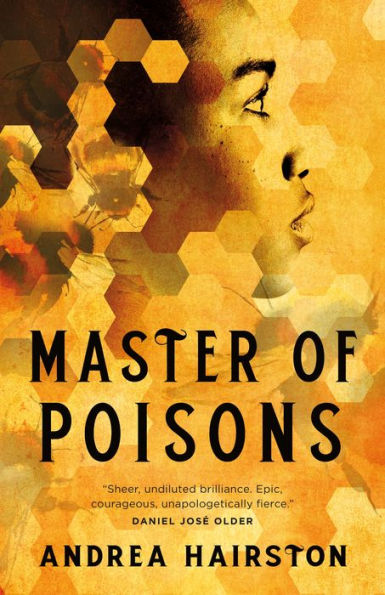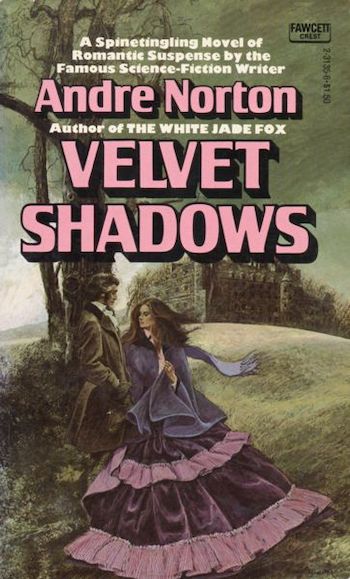I’m enjoying my excursion into Andre Norton’s small collection of Gothic romances. They’re not great examples of the genre, but for the most part they’re enjoyable. And sometimes, as I’ll get into in a bit, they lead in a fascinating direction.
This workmanlike entry into the canon makes an effort to stretch Norton’s authorial skills into something like sexual tension. It’s extremely rudimentary but it’s perceptible. The heroine actually feels attracted to the hero, and anguishes over it in more than one, for Norton, emotionally fraught scene.
The plot is fairly standard, but goes in some unusual directions. Tamaris is the orphaned daughter of a sea captain. She grew up on shipboard, has traveled the world and seen much, and is fluent in a number of languages including French and German. But her father was killed fighting for the Union in the American Civil War, and she found refuge in a school for daughters of the nouveau riche. There she constrained herself strictly according to the rules imposed on Victorian middle- and upper-class women.
As the novel begins, the mistress of the school has encouraged her to leave the safe nest and take a job as companion and watchful friend for a young girl of unusual provenance. Victorine is the half-sister of a wealthy man from San Francisco, born in odd and scandalous circumstances and raised in France. Her half-brother Alain comes from an aristocratic French family, but he is also part Creek Indian. He could claim the family title but will not.
Victorine has a very unsuitable suitor, a young man with close ties to the enslaved people of the Americas. Christophe is deeply embroiled in the world and culture of voodoo. So, apparently, is Victorine’s part-Black maid, Amélie, and Victorine herself.
Tamaris has to juggle her completely unsuitable passion for Alain, her job of trying to be Victorine’s friend and confidante while keeping Christophe from finding her, and a tangled web of political and social complications. There’s a voodoo queen who softly but relentlessly rules the African-American underworld of San Francisco, a voluptuous widow who is not as young as she wants to be and who has set her cap for Alain, another, older widow with a lumpish stepson and a startling past, and an assortment of maids and servants with various allegiances and affiliations.
For further thrills and chills, Victorine sports a remarkable necklace in the shape of a serpent, and her maid has a repellent bracelet shaped like a very lifelike and terrifying spider. There are druggings and kidnappings and frightful rituals. Tamaris almost becomes a sacrifice. Victorine and her maid both turn out to be not at all what they seemed to be. Tamaris finds friends in unexpected places, and fights and ultimately gives way to love.
It’s an oddly claustrophobic book, and that I think is intentional. Tamaris’ diehard determination to lock herself down into the merciless strictures of respectable femininity comes into constant conflict with her natural inclinations and her freewheeling upbringing. Events do not help her with this at all. She has to speak up for herself, act for herself, and contend with an ongoing series of threats to her respectability, leading through a succession of bordellos and worse, and ending in the voodoo ritual.
Luckily for her, her beloved is proudly and confidently unconventional, and he sees her for what she really is. Which is not at all easy, but Alain is a masterful Gothic hero, and he gets the job done. The moral of the story is that Victorian conventions were both suffocating and toxic, as manifested in the predilection for red velvet and decorative excess, and freedom is plain light-colored walls and simple decor—and women allowed to have sexual desires and actual functional lives.
Buy the Book


Master of Poisons
There’s another theme, too, that seems to have been near and dear to her heart. It’s problematical now in a number of ways, in this tumultuous summer of 2020, but for 1977 it was remarkably progressive. Much of the plot runs on the idea that enslaved and colonized peoples deeply and justifiably resent and even hate their oppressors. Hence the rise of voodoo in the Caribbean and the South, extending all the way into the West. Alain and Victorine’s family have appropriated both Native and African cultures in a literal way, through intermarriage, and those cultures have found ways to strike back.
The problem is that Alain the part-Native American is the “good” guy, and Victorine with her African-American connections and her evil yellow-eyed voodoo-prince lover is on the “bad” side. The racism here is not subtle, though I don’t think it’s conscious. Norton always granted Native cultures something like equality with white culture, but her Black characters and cultures tended to be subtly and not so subtly lesser, or as here, tending toward the literal dark side. Even the supposedly helpful voodoo queen is suspicious and slippery and not to be trusted. She has reason to be the way she is, but her form of resistance to white supremacy is portrayed as questionable and somewhat sinister.
Still, it’s a decent effort for its time. She’s thinking of things that white people have either not thought of at all or refused to think. She grants the enslaved and the colonized their right to be angry and even, within limits, to resist. She tries to understand.
I would have left at that point, feeling as if I could appreciate the effort but as a novel it doesn’t really work. I was disappointed that the old California ranch had been completely and hideously colonized, razed and built over with an overwrought Victorian monstrosity. Both Tamaris and Alain deplore it, and I get the thematic point, but honestly. Did she have to do that? Couldn’t we get an actual authentic rancho somehow? And why did they give it all up and move back east? What was the point?
But then, at the end, came an author’s note that changed everything. The voodoo queen, Mary Ellen Pleasant, turns out to have been a real person, and her story as Norton details it is extraordinary.
That’s the novel I wish we had, instead of limp, whiny Tamaris and her endless succession of claustrophobic rooms and her tedious family drama. I realize that Norton’s skills and inclinations were not up for it, and that this is not a book she could have written, but I want it. I want it so bad. Someone write it, please. I will bow before it.
I’ve managed to find another Norton Gothic, Iron Butterflies, which I had never heard of before it came up on a search. I’ll try that next.
Judith Tarr’s first novel, The Isle of Glass, appeared in 1985. Since then she’s written novels and shorter works of historical fiction and historical fantasy and epic fantasy and space opera and contemporary fantasy, many of which have been reborn as ebooks. She has even written a primer for writers: Writing Horses: The Fine Art of Getting It Right. She has won the Crawford Award, and been a finalist for the World Fantasy Award and the Locus Award. She lives in Arizona with an assortment of cats, a blue-eyed dog, and a herd of Lipizzan horses.











You might also read about Mary Fields, aka Stagecoach Mary, known as “one of the freest souls to ever draw breath or a .38.” She was the first African-American woman to work for the U.S. postal service and fought off wolves and outlaws to deliver the mail. She had a pet eagle and a personal exemption allowing her to got to saloons when Montana passed a law forbidding women from entering them. The only problem with doing an action adventure show based on her is that too many people wouldn’t believe it.
But, now I’ve got to read Norton’s book and find out more about Mary Ellen Pleasant.
i thought Mammy Pleasant was reasonably well known and well used in fiction…. She turns up in Powers’ Earthquake Weather, too, if you like Tim Powers work. And some others who aren’t coming to mind right now, although one might have been Fowler.
Black slaves’ anger from abuse was more than enough to fuel dark magic so this kind of story is justified in that sense, and voodoo back then wasn’t exactly bunnies and rainbows. Plus, Norton was writing a Gothic novel in the American West with a dark mansion. So, cool!
Norton always granted Native cultures something like equality with white culture, but her Black characters and cultures tended to be subtly and not so subtly lesser, or as here, tending toward the literal dark side.
Am suddenly reminded of Shann Lantee and his just-barely-coded lust for Dane Thorsen, whitest white man in space.
“. I was disappointed that the old California ranch had been completely and hideously colonized,”
Of course, the Mexican ranchos were themselves colonial projects. The Mexican government granted land to settlers as a way to facilitate the colonization of California. And the rancheros ruthlessly exploited the local California Indians, reducing them to near-slavery conditions.
“The problem is that Alain the part-Native American is the “good” guy, and Victorine with her African-American connections and her evil yellow-eyed voodoo-prince lover is on the “bad” side. The racism here is not subtle, though I don’t think it’s conscious. Norton always granted Native cultures something like equality with white culture, but her Black characters and cultures tended to be subtly and not so subtly lesser, or as here, tending toward the literal dark side. “
Pretty much what one would expect from an Anglo-American born in 1912.As bad as things were for American Indians, there was also a tendency to romanticize them. And people of partial American Indian descent were often warmly accepted by Anglo-American society. Henry Curtis, Herbert Hoover’s Vice President, was of American Indian descent. And Will Rogers, perhaps the most beloved celebrity in ’30s America, was part Cherokee. Had they been part Black, however, their careers would have been radically different.
@5 I have always held that the Native Americans have that position because they fought back as hard as they were able, sometimes inflicting serious victories against the Anglos (Greasy Grass, Fetterman, etc.) even though they would go down in defeat, the most tragic of which would be Wounded Knee. But because of that, they could be seen as warriors and were given a level of honor and romance that, for example, the ex-slaves never had.
Now at the same time as that romanization, there were the Indian schools trying and nearly succeeding in destroying Native American culture so it wasn’t all roses. Still, the noble savage of the cinema starts there.
‘I’ve managed to find another Norton Gothic, Iron Butterflies, which I had never heard of before it came up on a search. I’ll try that next.’
There’s also Snow Shadow, a more modern Gothic, and Wheel of Stars, an occult novel.
@7 Ooo, noted, thanks. I might have one or both of them. Will check the TBR pile.